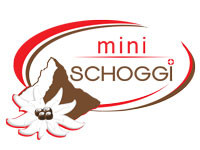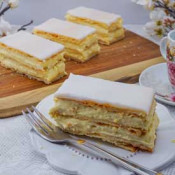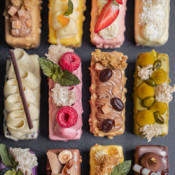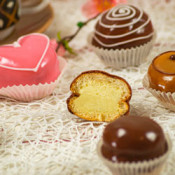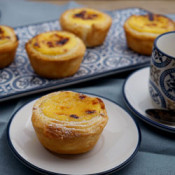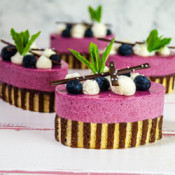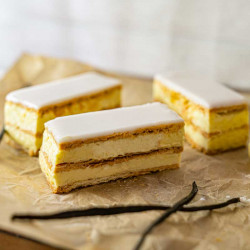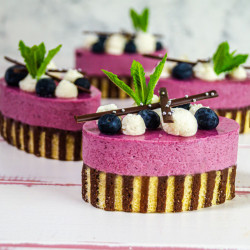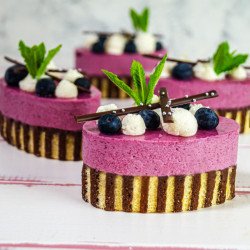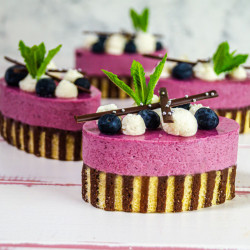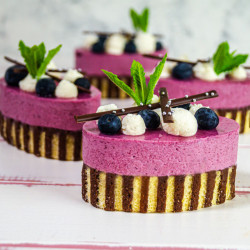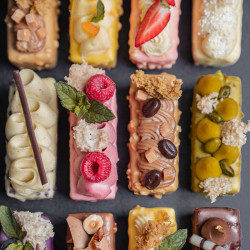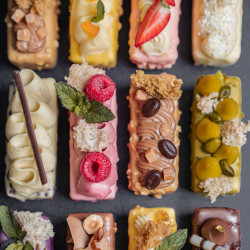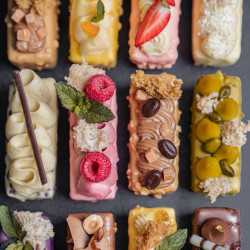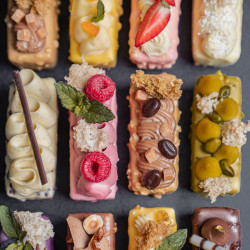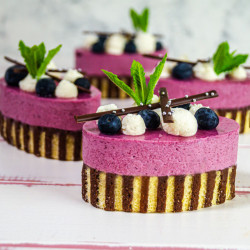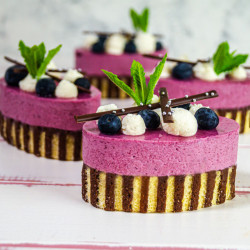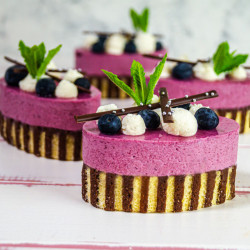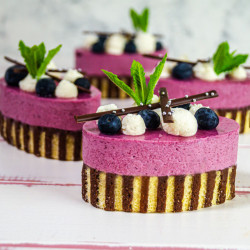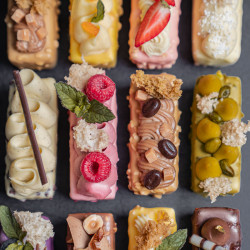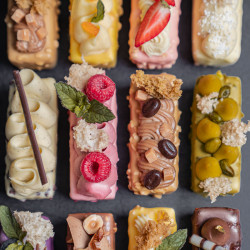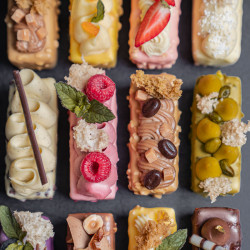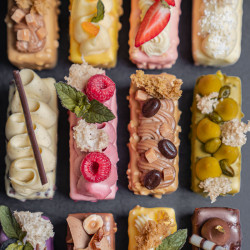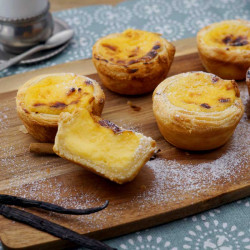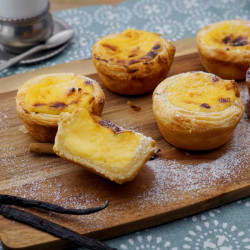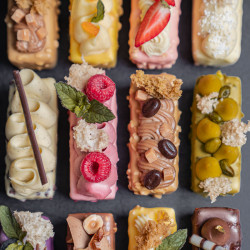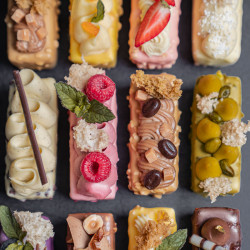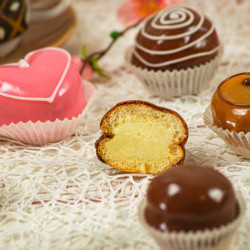Patisserie courses
Unterkategorien
Patisserie courses
The craft of patisserie is an art and inspires in all possible forms and flavors. Pastry stores offer small desserts of all kinds, macarons adorn the shop windows, behind the glass panes of the counters noble éclairs, strawberry tarts and vermicelles are presented and in the more elegant stores the sugar crust of the crème brulée is immediately flambéed fresh. You never go wrong with small patisseries, and the treats are great fun to make, too.
Welcome to miniSchoggi
A buffet with small patisseries looks incredibly great, but one or the other creation needs some practice and skill, but the most important thing is the right recipe. At miniSchoggi we show you how to make a wide variety of desserts very easily. With our recipes developed for you, nothing can go wrong. In the detailed course programs you will find all the important details and tricks for the perfect result. However, you will learn the most directly at our courses. With us, professional pastry chefs reveal all the important tips and tricks and show you right away exactly how the production works. For many desserts, it is the details that make the difference. On the macaron course, for example, you will be shown how to shape the shells so that they later become beautifully even, and on the éclair & pâte à choux course you will learn the perfect consistency of choux pastry. This way, the pastries made from it will be airy and hollow on the inside, but will not crack and will keep their shape. The techniques demonstrated can be tried out immediately. Often it is only when you try them yourself that you realize what questions remain. You can ask these right away at the course, our experienced course instructors will be happy to help you and thus equip you with the necessary knowledge for all possible creations.
Dessert course
For a family celebration, a dessert buffet or a cozy get-together with friends, you need a suitable treat. At our dessert course, you will learn about various delicious desserts that are perfect for different occasions. For example, you will make a delicious apple strudel, which can be refined with other ingredients as you wish. Sprinkled with a little powdered sugar, it can be enjoyed while still warm or cooled down. Those who prefer it cold will love our Semifreddo. A convenient push-up dessert, the semifreddo can be stored in the freezer for a long time and brought out for the appropriate occasion. At the course you will create a simple basic recipe, which can be refined and supplemented with a wide variety of ingredients. So you can add fruits, chocolate or nuts and make your own personal favorite semifreddo.
With the Panna Cotta you will learn the recipe of a varied and light cream. It is very easy to prepare in small cups and can also be flavored as desired. The cream tastes best with a matching fruit jelly, which gives it the perfect freshness. The lemon tartlets with small meringue dots are at least as refreshing. The slightly tart lemon cream harmonizes perfectly with the crispy shortbread tartelette and is perfectly complemented by the lightly flattened meringue decoration.
One of the more elaborate creations in the course is the Williams pear dessert. A ball of white chocolate mousse carries a core of dark chocolate mousse with a pear jelly and is covered by a fine Mirror Glaze. The treat is then served well chilled on a sponge cake base.
For particularly noble desserts, which are best completed just before enjoying, include the crème brulée and the lava cake. The sweet French crème can be made classically with vanilla or with a fruit puree. Just before serving, a little cane sugar is sprinkled on top and caramelized with a Bunsen burner. This creates a wonderful sugar crust that will enchant your loved ones. The special thing about the lava cake is its core. If it is taken out of the oven at the right time and enjoyed right away, you will be rewarded with a liquid chocolate center that goes best with a scoop of vanilla ice cream.
With these desserts you have the right recipe ready for every occasion and can thus enchant friends and family with a wide variety of treats.
Éclair & Pâte à Choux course
In French patisserie, éclairs are at least as famous as macarons. This course is all about making the perfect choux pastry and its airy fillings. If the dough is too firm, the pastries will not rise and cannot be filled well, but if it is too moist, the éclairs will crack and not look as elegant. Our course instructor will show you exactly how to recognize the perfect consistency and how to shape the dough correctly. This way, the Éclairs and Choux will be beautifully even and hollow, so that they can be finished with delicious fillings afterwards. But before that, you can decorate the homemade delicacies with crunchy chocolate, petals, crispy pearls and fine chocolate chips. The finished Éclairs and Choux are then nicely packaged and prepared for transport. In this course you will also learn how to make the noble St. Honoré cake. This is made with a crisp puff pastry base and a border of caramelized choux. An airy filling completes the whole and with some berries, leaves and chocolate spirals the cake is nobly decorated.
More desserts
Of course, there are many other delicious desserts, especially popular are, for example, noble cakes, for a Zvieri with friends or as a gift is a tart or a simple cake suitable. How to make these delicacies, you will learn at our cake specialist courses or our Cakes & Tartes course. Glaces and sorbets are also perfect for a summer dessert. These are introduced to you in our Glace course.
Our desserts The desserts you encounter in the confectioneries always look delicious, but how they are constructed or what is behind the individual names is not always entirely clear. Therefore, we explain here the individual creations that are made at our courses.
Crème Brulée - Another delicious French dessert is crème brulée. Baked in a bain-marie with cream, egg and sugar, it is closely related to the Crema Catalana from Spain and the baked cream or Brönnti Creme, as it is called in Switzerland. This dessert was made in France as early as the 17th century and is especially popular thanks to its delicious caramelized sugar crust.
Lemon tartelettes - The small version of the lemon meringue tart impresses with a slightly sour lemon cream on a crispy shortcrust pastry base. The cream is very close to lemon curd, this is an English specialty that is also very well known in countries such as Ireland, America and Australia. The ancestor of this mass was probably a cream of bitter oranges from the 18th century. Today, the curd is often served as a flat tart or on smaller tartelettes with a meringue topping.
Lava cakes - Most people know this dessert as chocolate cakes with a liquid center. The art here is in the perfect baking time. If it is baked too long, the liquid core is no longer visible, if you take it out of the oven too early, not only the core but the whole dough is still soft. Especially delicious is the combination of the still warm cake with a scoop of vanilla ice cream, this contrast of hot and cold provides the perfect mixture.
Semifreddo - This Italian specialty is very easy to make and allows all kinds of flavor creations. The basic mass consists of egg, sugar and cream, with nuts, fruits, berries, flavors or syrup can be added and refined. So the whole thing is frozen and stored until you need it. Then the dessert can be taken out of the freezer about 10 minutes before serving, so it is nice and cold but not quite frozen anymore and makes for a perfect refreshment.
Williams pear dessert - This is a particularly noble but also somewhat more elaborate dessert. The preparation is not necessarily difficult, but involves many individual steps, each of which takes a little time, but the work invested is worth it! Frozen chocolate mousse balls are placed in a silicone mold filled with white chocolate mousse, along with a small pear jelly. The whole thing is frozen with a thin sponge. It can then be unmolded and covered with a noble Mirror Glaze and served.
Apple strudel - strudel is typically Austrian, it was already baked there in the 17th century, but originally we probably owe the treat to the Arab countries. The strudel dough is related, for example, to baklava, a strudel pastry dipped in honey and sugar syrup. In addition to the fruity lightness of apple strudel, the complementary options are a big bonus. In addition to the typical ingredients such as apples, cinnamon, almonds, raisins, breadcrumbs and nuts, many other goodies can be baked in. This way, everyone creates their own favorite strudel.
Panna Cotta - The Italian cream dessert impresses with a perfect firmness, the cream does not melt, but is also not yet as firm as a pudding. Of course, it can be flavored, but the most typical is the relatively neutral vanilla version. This tastes best combined with a fruit sauce or fruit jelly. This addition is still relatively new, but pure panna cotta was already enjoyed in the 10th century in Piedmont.
Éclair - Éclair is French and means lightning, but where exactly the name comes from is not known and offers so much room for interpretation. For example, people speculate that the pastry was so named because the slightly jagged shape is reminiscent of lightning, the glaze is so beautifully shiny, or because it is eaten in a flash. In fact, the airy pastries are very popular and so also eaten quickly. Choux pastry must be toasted, so the contained egg white and flour stick together. This results in a vapor-impermeable layer, which leads to the typical cavities inside during baking. The filled Éclairs, Choux, Profiteroles and cream puffs can then be perfectly filled with delicious creams. Typically, the Éclairs are still apricotized and glazed with a noble coating of liquid fondant, which gives you your familiar, shiny appearance.
